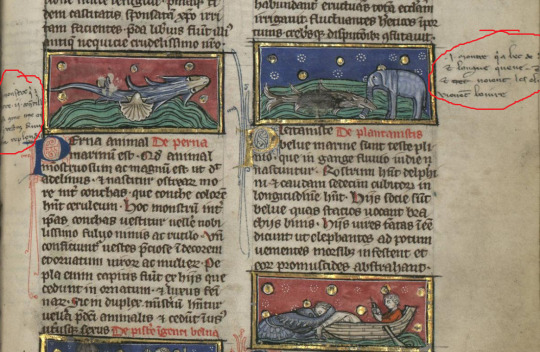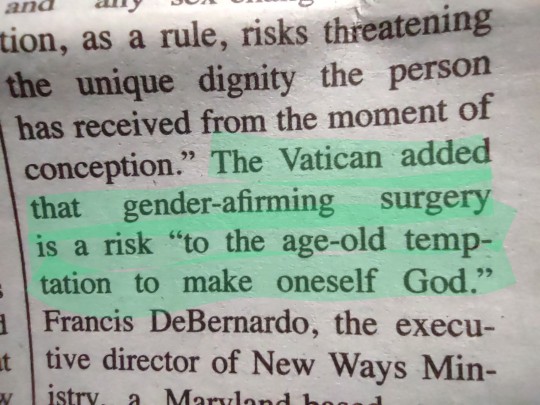Poking at Abrahamic religions with a stick. Also language sometimes. Sideblog
Don't wanna be here? Send us removal request.
Text
Blind people gesture (and why that’s kind of a big deal)
People who are blind from birth will gesture when they speak. I always like pointing out this fact when I teach classes on gesture, because it gives us an an interesting perspective on how we learn and use gestures. Until now I’ve mostly cited a 1998 paper from Jana Iverson and Susan Goldin-Meadow that analysed the gestures and speech of young blind people. Not only do blind people gesture, but the frequency and types of gestures they use does not appear to differ greatly from how sighted people gesture. If people learn gesture without ever seeing a gesture (and, most likely, never being shown), then there must be something about learning a language that means you get gestures as a bonus.
Blind people will even gesture when talking to other blind people, and sighted people will gesture when speaking on the phone - so we know that people don’t only gesture when they speak to someone who can see their gestures.
Earlier this year a new paper came out that adds to this story. Şeyda Özçalışkan, Ché Lucero and Susan Goldin-Meadow looked at the gestures of blind speakers of Turkish and English, to see if the *way* they gestured was different to sighted speakers of those languages. Some of the sighted speakers were blindfolded and others left able to see their conversation partner.
Turkish and English were chosen, because it has already been established that speakers of those languages consistently gesture differently when talking about videos of items moving. English speakers will be more likely to show the manner (e.g. ‘rolling’ or bouncing’) and trajectory (e.g. ‘left to right’, ‘downwards’) together in one gesture, and Turkish speakers will show these features as two separate gestures. This reflects the fact that English ‘roll down’ is one verbal clause, while in Turkish the equivalent would be yuvarlanarak iniyor, which translates as two verbs ‘rolling descending’.
Since we know that blind people do gesture, Özçalışkan’s team wanted to figure out if they gestured like other speakers of their language. Did the blind Turkish speakers separate the manner and trajectory of their gestures like their verbs? Did English speakers combine them? Of course, the standard methodology of showing videos wouldn’t work with blind participants, so the researchers built three dimensional models of events for people to feel before they discussed them.
The results showed that blind Turkish speakers gesture like their sighted counterparts, and the same for English speakers. All Turkish speakers gestured significantly differently from all English speakers, regardless of sightedness. This means that these particular gestural patterns are something that’s deeply linked to the grammatical properties of a language, and not something that we learn from looking at other speakers.
References
Jana M. Iverson & Susan Goldin-Meadow. 1998. Why people gesture when they speak. Nature, 396(6708), 228-228.
Şeyda Özçalışkan, Ché Lucero and Susan Goldin-Meadow. 2016. Is Seeing Gesture Necessary to Gesture Like a Native Speaker? Psychological Science 27(5) 737–747.
Asli Ozyurek & Sotaro Kita. 1999. Expressing manner and path in English and Turkish: Differences in speech, gesture, and conceptualization. In Twenty-first Annual Conference of the Cognitive Science Society (pp. 507-512). Erlbaum.
90K notes
·
View notes
Note
Genuine question because I don't understand.
An exegete is, from what I can see, someone who studies a religious text in an academic/research/understanding sense and then interprets it.
So you're asking for someone to cite a paper written by an exegete about what an angel really looks like; not cite a bible verse or their own interpretation unless they have whatever qualifications make them an exegete?
Separately, can someone like a rabbi or a imam be an exegete, or does it specifically imply an outside or nonreligious view?
That's a good question!
The term exegesis is most useful for people trying to figure out what a particular passage from a text means. Multiple experts may have different opinions, so it's useful to compare the different exegetical theories to form your own exegesis etc etc.
The term exegete generally refers to someone who wrote their exegesis down. Be it a rabbi writing a commentary on a passage, an imam writing about the words of the prophet, or even an atheist historian writing about their interpretation of the bible.
So while your friend reading the Bible and giving their opinion is by definition doing some exegesis, calling your friend an exegete for chatting about the Bible is a bit like calling your friend a writer because they scribbled down a shopping list.
261 notes
·
View notes
Text
Child's Writing Exercises and Doodles, from Egypt, c. 1000-1200 CE: this was made by a child who was practicing Hebrew, creating doodles and scribbles on the page as they worked

This writing fragment is nearly 1,000 years old, and it was made by a child who lived in Egypt during the Middle Ages. Several letters of the Hebrew alphabet are written on the page, probably as part of a writing exercise, but the child apparently got a little bored/distracted, as they also left a drawing of a camel (or possibly a person), a doodle that resembles a menorah, and an assortment of other scribbles on the page.
This is the work of a Jewish child from Fustat (Old Cairo), and it was preserved in the collection known as the Cairo Genizah Manuscripts. As the University of Cambridge Library explains:
For a thousand years, the Jewish community of Fustat placed their worn-out books and other writings in a storeroom (genizah) of the Ben Ezra Synagogue ... According to rabbinic law, once a holy book can no longer be used (because it is too old, or because its text is no longer relevant) it cannot be destroyed or casually discarded: texts containing the name of God should be buried or, if burial is not possible, placed in a genizah.
At least from the early 11th century, the Jews of Fustat ... reverently placed their old texts in the Genizah. Remarkably, however, they placed not only the expected religious works, such as Bibles, prayer books and compendia of Jewish law, but also what we would regard as secular works and everyday documents: shopping lists, marriage contracts, divorce deeds, pages from Arabic fables, works of Sufi and Shi'ite philosophy, medical books, magical amulets, business letters and accounts, and hundreds of letters: examples of practically every kind of written text produced by the Jewish communities of the Near East can now be found in the Genizah Collection, and it presents an unparalleled insight into the medieval Jewish world.
Sources & More Info:
Cambridge Digital Library: Writing Exercises with Child's Drawings
Cambridge Digital Library: More About the Cairo Genizah Manuscripts
10K notes
·
View notes
Text
"There was a case where a certain man set his eyes on a certain woman and his heart became [so] consumed with burning desire [that his life was endangered]. When doctors were consulted, they said, "His only cure is that she submit to him." The sages responded, "Let him die rather than have her yield." "Then let her stand naked before him," [the doctors said]. "Let him die rather than that she stand naked before him." "Then let her at least talk to him from behind a fence." "Let him die rather than that she talk to him from behind a fence."
- Babylonian Talmud, Sanhedrin 75a
"This passage, one of the most misunderstood in the Talmud, has led more than a few people to conclude that the sages were so puritanical that they deemed it preferable that an unmarried man die rather than converse with an unmarried woman.
However, this narrative has little to do with illicit sexual behavior; it really concerns emotional blackmail. Imagine the societal damage that would ensure if whenever one person's will was thwarted by another, the rejected party said he [or she] would die if the other party did not grant whatever he or she wished. Ultimately, the fact that this man is obsessed with this woman is his problem, and his alone (the Talmud provides no indication that the woman had led him on); thus, he is not entitled to make demands of her. As Hyam Maccoby insightfully notes: "What the story is really telling us is that no woman is required to sacrifice her status or dignity for the sake of a madman."
What makes this case so unusual is the doctors' claim that the man's life is at stake. Normally, when such a diagnosis is made, Jewish law permits a whole range of otherwise forbidden activities. For example, if the doctors had said the man must eat unkosher food lest he die, the Rabbis would have permitted it. But Jewish law never permits imposing unreasonable demands on others, even when a life is at stake. Thus, if the same man should insist that his cure is conditional on other people's eating unkosher food, this would not be permitted. Standards of behavior in Jewish life cannot be determined by the insane or the intransigent."
-Jewish Wisdom, Rabbi Joseph Telushkin, pages 133-134
3K notes
·
View notes
Text
i think the struggle of religious minorities and of irreligious people in the US is inherently linked, which is why i wish people would consider more often if they mean "christianity" when they say "religion," but there's really no way of dying on that hill without sounding like a jumblr blogger, is there
870 notes
·
View notes
Text
when we were studying the bible in literature class (so we have the context necessary for later works that reference the bible), i think we were at the book of jonah, and one of my classmates was studying the text very intently, and then looked up and earnestly said "professor, i don't understand the will of god"
the teacher was just like. well sadly i am a literature teacher and not a priest so i can't help you there. but if it helps, many people throughout history had the same problem.
26K notes
·
View notes
Text
Anyone have official vatican-sanctioned anime mascot of the Catholic church on their 2024 bingo?

10K notes
·
View notes
Text
Here's the long-promised Latin resources masterpost! Resource recs are always appreciated and I'll try to update this post from time to time. :)
Study and fluency tips, plus my review of a few different Latin textbooks here
Free online resources here
Suggestions for if you've studied Latin in the past and want to brush up/re-learn here
Tips for expanding vocabulary here
Links for Latin literature and suggestions on which works to start with here
Salvete!
1K notes
·
View notes
Text
I think we can solve several problems at once if we just assume each member of the Trinity has a different fursona
3K notes
·
View notes
Text
Hey tumblr we need to have a talk about something I noticed.
Specifically going by tags attached to images I’ve blogged or reblogged, there seems to be a misconception that marginalia means “any quirky medieval art”.
It’s not.
Marginalia is anything in the margins of a text.
The ones that will get posted on tumblr will more often than not be quirky drawings, but they also include notes, annotations, scribbles, and whatever else. The quirky drawings just happen to get a lot of press on here because, well. They’re quirky drawings.
For instance, see this image here of a platanista (river dolphin) chomping down on an elephant’s trunk?

This is not marginalia! This is a full-fledged illustration. It’s within the text (Liber natura rerum, Thomas de Cantimpré, Librairie de Valenciennes Ms 0320). It illustrates the entry on Platanista.
This is what it looks like in context.

But you know what are marginalia? Let me circle them for convenience.

Know the difference. It won’t save your life but it will make you more popular at a medievalist conference.
#marginalia#yeah my marginalia tag is not for literal marginalia#I should make a note of that in my tagging guide
5K notes
·
View notes
Text

[image description: the bugs bunny in a tuxedo "I wish all (blank) a very pleasant (blank)" meme edited to say "I wish all of my Jewish followers a very pleasant rosh hashanah". In front of Bugs there is a jar of honey, a stack of apples and pomegranates. In front of bug's mouth there is a shofar.]
58K notes
·
View notes
Text
Do you think they realize how much cooler that makes it sound?

Like. I'm not even an apotheosis type of guy. But you do know that makes it sound so much cooler right?
87K notes
·
View notes
Note
Hi, I just came across this post on this lovely app and shared it in a discord and we were wondering if it would qualify as false idolatry? Could we get your expert's point of view ?
Thank you
(love your blog)

Without knowing the specifics I can only guess. However, AI generated content in general is not allowed because it removes one from the act of creation and the right to labor.
The better question to ask is what’s the point going to a church where the sermons and lessons are not written by anyone?
96 notes
·
View notes
Text
although I find both institutions detestable I think they should force the vatican to compete in the Olympics. let's see what those priests can do
91K notes
·
View notes
Text

"Sebastian, he/him"
Oil on canvas, 2023
Tip me on ko-fi (DM to ask about prints)
17K notes
·
View notes

